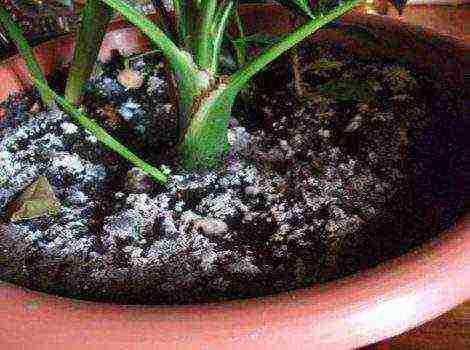Content
- 1 The best varieties of indoor lemon
- 2 Which is better to buy - an adult plant or seedlings
- 3 Planting lemon pits
- 4 What capacity to choose
- 5 Growing lemon at home
- 6 Crown formation
- 7 Lemon transplant
- 8 Lemon care at home
- 9 How to plant lemon
- 10 Reproduction of lemon indoors
- 11 Indoor lemon pests and diseases
- 12 Growing lemon at home
- 13 How to grow lemon at home - video
- 14 Room lemon - a short description
- 15 Growing features
- 16 Planting lemon
- 17 Care features
- 18 Top dressing and fertilization
- 19 Pruning
- 20 Lemon transplant
- 21 Reproduction
- 22 Bloom
- 23 Problems, diseases, pests
- 24 Popular types of indoor lemon
- 25 Useful Tips
- 26 Answers on questions
- 27 What kind of lemon is best to grow in an apartment?
- 28 How to plant a lemon correctly?
- 29 How to grow lemon at home?
- 30 How to propagate homemade lemon?
- 31 Growing lemon - diseases and pests
Lemon is native to tropical India and China. The lemon tree was first cultivated for food and decorative purposes in the subtropical countries of Asia.
To this day, citrus fruits are grown on a large scale there, as well as in Spain and Italy.
In the CIS countries, lemon is grown as a houseplant.
This beautiful tree with a neat crown exudes phytoncides (substances that disinfect the air) useful for our apartments and, when grown correctly, gives aromatic and vitamin fruits.
In our article, you will learn all the intricacies of turning a small seed into a fruiting lemon tree.
The best varieties of indoor lemon
Most popular, well-established varieties for apartments and houses in temperate latitudes:
- Pavlovsky - differs in low growth, the tree perfectly tolerates low illumination and is adapted to life in apartments
- Anniversary - a low (up to 1.5 m) tree, resistant to the dry air of apartments, has a high yield, bears fruit and grows quickly. Fruits have a thick skin
- Panderosa - indoor hybrid of lemon and citron. A short and bushy tree forms a beautiful crown. At the age of 2 years already bears fruit
- Meyer Is a lemon-orange hybrid well adapted to indoor living.
Which is better to buy - an adult plant or seedlings
For growing at home, novice flower lovers can already buy adult plant: problems and hassle of growing will be less.
True, the price of such a lemon will be higher than that of a young seedling. Saplings can cost from 200 rubles, and an adult plant is about 1000 rubles.
And yet it is much more interesting to grow it yourself from a seedling, observing its growth day after day. Better yet, grow your tree completely from bone.
It's not easy, but getting a full-fledged, beautiful and fruiting lemon is quite possible. Across 5-7 years (with the right approach) you can admire the view of an evergreen tree and drink aromatic tea with your own lemons.
Planting lemon pits
The very first step is to eat the lemon and pick out a few large seeds. Take better 10 and more bones.
It is advisable to prepare them: for successful germination and growth of roots, you need to process the bones growth stimulant - a solution of sodium humate (it is sold in a botanical store), in which the bones must be dipped for a day.
Then you can further process the seeds other stimulants - solution of the drug "Citron" or "Epinas-extra". This manipulation will allow future young plants to withstand low light conditions and dry air.
Important! For germination, take fresh whole seeds and immediately plant them in the ground. The germination success is increased several times!
What capacity to choose
You can plant the seeds in a pot or small temporary containers (cassettes or boxes). It is better to take a clay pot for planting seeds, about 7cm in diameter.
Priming for planting consists of:
- parts of humus;
- part of the river coarse sand;
- parts of turf (you can dig it up, for example, in a meadow);
- parts of leafy land (it can be dug up in a deciduous forest);
- 1/4 some of the charcoal.
The soil should turn out loose... But you can do it easier: go to a botanical store and buy a special soil, which indicates that it is for citrus fruits.
They plant seeds in prepared soil to a depth 1.5 cm... To prevent decay, you need to cover the ground with a film or a transparent bag and spray it with water every day from a spray bottle.
Germination temperature should be around + 18 ° C.
Seedlings will appear later 3 weeks... After that, you need to transfer the containers to a bright place, and remove the film after the second pair of sheets appears.
Note! Do not over-pour or overcool the lemon seedlings! Avoid drafts and do not use fertilizers!
Then produced selection of seedlings: rejection of the worst and selection of the strongest, with a stocky trunk, preferably without short needles, but with a large number of leaves, without long thin shoots.
Growing lemon at home
For successful growth, a young lemon needs heat, light and water... There are some peculiarities to be considered in the requirements for citrus fruits.
In the first months, you do not need to feed the lemon. In spring and summer, for a grown plant, they use fertilizers.
The botanical store will offer you the necessary ones and tell you in detail how and how much to apply them, plus any fertilizer is always issued instruction.
Watering should be regular, but not excessive. Water the lemon every day in the heat, on other days - as the top of the soil dries. Summer - 5 times per week, in winter - 2 times per week.
How much water to pour depends on the age of the plant and the air temperature. A young seedling will need about a glass of water at a time, and an adult tall tree - from 0.5 to 1 liter of water.
The main thing, spray the plant daily, as lemons do not tolerate dry air. In the spring, the plant is watered in the morning, and in the fall and summer - late in the evening.
In the summer, you can take it out on the balcony or take it to the village. The main thing is that you cannot put a tree under direct sun... It should be rotated daily so that the branches grow evenly.
For wintering, it is advisable to take the tree to a room with a temperature about +15 ° С, but not lower than +12 ° С... If this is not possible, it is recommended to additionally illuminate the lemon with special lamps.
It is important not to forget to clean the leaves from dust so that the gas exchange process takes place at the proper level.
Crown formation
Lemon branches not very readily. To create a beautiful and compact crown, you will have to work a little.
Aged up to 1 year, or better yet, from 3 months, begin to stimulate the growth of lateral branches. This is how it is done.During the period of increased growth, the tip is pinched off.
Sometimes it gets pinched off repeatedly, since the lemon can stubbornly continue to grow only to the top. As a result, the axillary buds wake up and the lateral branches grow.
The tops of the lateral branches are also plucked off early, when 2-3 sheets... In this way, the crown of the lemon is formed in the future.
It is important not to allow the appearance "Tops" - too long inner branches from the crown. While the "tops" are flexible, they are tied to a stick stuck in the ground so that they take root.
Lemon transplant
When the roots of a young plant begin to entangle the pot, it is transplanted. In the first year, the transplant is performed 2 times... An adult plant can be transplanted every 4 years.
The transplant is carried out in early spring... Move the lemon into a new pot of slightly larger diameter, adding fresh soil.
Do not damage the roots, as citrus fruits contain mycorrhiza - a symbiosis of fungi and roots useful for lemon.
The appearance of mycorrhiza on the roots is a biological feature of citrus fruits. A similar phenomenon is observed in legumes - they have nodule bacteria in symbiosis with the roots.
Because of this lemons do not tolerate a transplant... So that the plant does not suffer, you need to minimally touch the earthen ball surrounding the root system.
When no transplant is made, the land is simply renewed by adding a little fresh soil... Periodically, the soil is loosened to regulate respiration.
Lemon care at home
Lemon is a capricious plant:
- It can be involuntarily acidify or pour;
- He poorly tolerates temperature extremes, drying;
- Loves light;
- Dislikes frequent movements.
Proper feeding plays an important role. Overfeeding, like a lack of fertilizer, will not be beneficial.
Begin to feed the lemon in the spring.
From February to September, special fertilizers for citrus fruits are regularly applied ("Lemon", "For citrus fruits", "Citrus", etc.). In winter, the tree is not fertilized.
In preparation for winter and at the end of February decrease by 2 times the usual concentration of the applied fertilizer. A sign of an excess of fertilizer is a dry border along the edge of the leaves and their quick fall.
Flowering occurs after a few years. But purchased prepared seedlings can bloom in the first year. For a lemon to bear fruit, it must pass 10-15 years old from sprouting from the seed, but the process can be accelerated. For example, by vaccination.
How to plant lemon
Graft Is a procedure that accelerates flowering and fruiting. It is carried out with pitted lemon and simple seedlings.
The stock is the plant to be grafted. The first vaccination is given 2-3 year old tree.
Graft the upper cuttings from other plants (maybe even from an orange). The leaves are harvested, leaving the axillary buds.
It is best to plant in early spring. There are 2 ways to vaccinate:
- Kidney vaccination. With a special budding knife, they carefully cut out a small bud from another plant, while trying not to touch the cut with your hands. Then a T-shaped incision is made in the rootstock, where this bud is inserted. This place is then tied with a plaster. Engraftment will take place in 3 weeks. The part of the shoot that is located above the bud is soon cut off (about 10 cm in height)
- Inoculation by cuttings carried out with a special grafting pruner. The cuttings should be young with bark and several buds. You need to cut them obliquely. On the rootstock, the bark is split along and the cut cutting is inserted there. This place is then also rewound until the cutting is completely engrafted.
Better to buy cuttings from a lemon that has already borne fruit. Then there will be fruits already on 3 year.
Also, to accelerate fruiting, lemon can be pollinate, transferring pollen artificially from one flower to another.
Reproduction of lemon indoors
You can not only graft, but also propagate a lemon in a vegetative way - cuttings.
The easiest one is to cut off cuttings from an already fruiting tree and plant them in a new pot.
To do this, a cut is made from an adult lemon under the lower kidney near the cutting. The stalk itself must be more than 10 cm and have more 5 leaves.
Lower 2 sheets removed, the cut is powdered with charcoal and the twig is rooted in the sand to a depth 2 cm... You can plant a future seedling in a greenhouse, a greenhouse, under a film, where the temperature reaches at least +20 ° C.
In a month there will be first roots... A rooted stalk now requires the same care as a regular young plant.
Indoor lemon pests and diseases
Lemon is a delicate plant. He is exposed many diseases, both from improper care, and from various parasites.
One of the most common problems is yellowing of leaves.
This can happen:
- From lack of nitrogen (leaves turn pale green) phosphorus (dull, narrow, yellowish), potassium (the leaf is lighter in the center, and turns brown along the edge);
- From a lack of trace elements iron, sulfur, magnesium, zinc, excess calcium (chlorosis);
- From lack or excess of light;
- As a result of defeat phytopathogenic fungi (rust);
- Due to pests: spider mite (yellow dots) and aphids (light sticky spots).
Another problem is young branches turn black... This can happen if the roots are affected, namely:
- They rot;
- Dried up;
- Frozen;
- Dead mycorrhiza;
- Happened overfeeding with fertilizers.
To save and preserve the lemon, you need to check the roots as soon as possible, put the soil in order. It is best to avoid such problems, but to carry out timely disease prevention indoor lemon.
Features of growing lemon from seed at home, you can watch in this video:
Rate the article
Growing lemon at home
Features of indoor lemons
Lemon is a subtropical plant. It grows where there is a lot of warmth and moisture, which should accompany it all year round. Lemon trees die when the ambient temperature drops to minus 4 degrees. Lemons are also light-loving. It should be remembered that direct sunlight when growing indoors depress the plant, sometimes causing foliage to fall off.
In nature, lemon leaves do not fall at the same time. This is not only the organs of photosynthesis, but also a kind of storehouse of useful substances.
How to grow lemon at home
When growing, there is a direct relationship between their quantity, intensity of development and yield.
Lemons grow at home at regular intervals. A new growth starts when the young foliage is finally ripe. The first wave of growth lasts from late March to June. The second begins after a short period of dormancy from mid-June to early August, and the third - from about the second decade of September to the last days of October. Lemons are dormant from November to early March. The trees grow 15–20 cm per year.
Often, the apical bud dries up and falls off during the dormant period, while young leaves develop rather quickly. Each time growth stops, young shoots ripen. The next growth begins after they get stronger. The upper buds germinate first and develop better than the lower ones, that is, vertical shoots are more active in growth, in contrast to horizontal ones. On vertical ones, fruits are very rarely tied, so the crown must be formed. How well it is formed depends on the start of fruiting.
It all starts with a seedling
You cannot buy lemon saplings brought from the south. They are mostly grafted on tripolyates, which fall asleep in winter. Such seedlings shed their foliage in indoor conditions and die.
Even if the grafting was carried out on lemons at home, the southern seedlings in the north do not feel good.The leaves of such scions are formed based on excessive southern illumination. With a sharp change in these conditions, plants are simply not able to function normally.
It is best to purchase them from a local hobbyist who has experience in growing lemon at home and will be able to advise if necessary. The seedling should grow in a well-sized pot and have three to four mature leaves.
You cannot buy seedlings for growing with a bare root system. The fact is that it does not have thin villi for absorbing nutrients and moisture from the soil. The mycorrhiza fungus lives on the smooth tips of the relatively thick roots. If the root system remains exposed even for a short time, the mycorrhiza dries quickly and the seedling dies soon after planting.
Formation and cultivation of the crown
When young shoots grow from under adult leaves, begin to form a crown. Each branch is shortened to five to six leaves, and then, when it becomes large, the leaves are wide, dark green, firm, a branch with two leaves is cut off with scissors or shears. Subsequently, on the left part, two or three new shoots will grow, which will again need to be shortened. A beautiful tree can be formed within two years.
The plant must be allowed to bloom and bear fruit at the age of three to four years. In this case, you should not leave an excessive ovary. The fruits will form and ripen, but will the young plant withstand them? It can hurt for a long time or die.
Ten mature leaves are capable of ensuring the full development of one fruit under room conditions. Guided by this norm, the extra flowers are removed. This is best done while they are still budding.
Tree care and further cultivation
Determine the place where the lemon will constantly stand at home. The seedling must acclimatize to living conditions for one to two months. After that, it should be transplanted into a spacious pot with a hole in the bottom.
The root system of the plant is superficial, so the soil in the container must be drained. To do this, a piece of broken ceramics is placed over the hole, and then charcoal is poured in a layer of 4–5 cm (it also reduces the acidity of the soil). If there is no coal, you can use expanded clay. The drainage is sprinkled with a nutritious earthen mixture consisting of soil from under deciduous trees (except for oak) and sand (3: 1). You can add three tablespoons of ash and a glass of loose humus to the mixture.
The best soil for growing indoor plants is from molehills. The soil that moles dig when building their own shelter is very nutritious, fluffed, thoroughly cleaned of insects. If the tree is transplanted into such land, then you can do without feeding. Note that soil acidity is very important for lemons. They develop best at pH 5.5–7.5. Increased or decreased acidity causes a deficiency of trace elements even with regular fertilization, because most of the substances are transformed into a form inaccessible to plants.
When the pot of soil is prepared, the plant is removed from the old flowerpot. Any citrus fruits are transplanted with a clod of earth so as not to disturb the sensitive roots. Such a transfer is called a full transshipment. It is important not to sprinkle the root collar (the junction of the root with the trunk) with a layer of soil thicker than 1 cm, otherwise it will start to rot.
After transplanting, the lemon at home is poured with water at room temperature, in which sodium permanganate crystals are dissolved. In the future, it is transplanted only on the condition that the roots are completely entwined with an earthen lump in a pot. You can notice this by the roots that come out through the drainage hole.
They are also transplanted when the tree stops growing, underdeveloped branches appear, and the leaves turn yellow. It is best to do a transplant in February.Here the question arises: why can't you plant a seedling immediately in a pot of impressive size, so as not to do it every year? Yes, because the root system of a small tree covers a correspondingly small volume of earthen coma, and the rest - "idle" earth - turns sour.
A pot with a seedling is wrapped with a layer of cotton wool, batting or foam rubber and aluminum foil. This method of growing the root system appears to be in a thermos: in winter it will not be cold, and in summer it will not be hot.
For better illumination of plants in winter, it is advisable to install an aluminum foil screen on the side opposite to the window. If there is heating under the window, then it is better to cover it so that warm air does not fall on the leaves.
Lemon at home cannot be rearranged from place to place and turned in different directions. This can lead to leaf fall and the death of the seedling.
Watering and sprinkling lemons at home
It is better to water the tree with rain or melt water. However, you often have to take it from the tap, which contains disinfectants. In order not to harm the plant, you should defend the water for irrigation.
Well water often contains mineral salts, most often lime. With constant watering, the soil is saturated with "ill-wishers" so much that it acquires an alkaline reaction, and the plant loses its ability to absorb iron, manganese, zinc, and further cultivation becomes difficult. Lemon leaves become pale, covered with spots. If the tree is not transplanted, then it will disappear altogether. It softens hard water by simple boiling or lemon (0.5 g per 1 liter), nitric, acetic acid (4 drops per 1 liter).
At any time of the year, it is important to spray the lemon daily at home. This should be done especially in winter when the air is too dry. This activity helps to reduce the evaporation of moisture from the leaves and thus facilitates the vital activity of the roots and the cultivation is more intensive.
How and what to feed when growing
The first time a lemon is fed at home 30 days after transplantation. In winter - once a month, and in spring-summer - once a week. It is advisable to regularly change the set of nutrients. Dry chemical fertilizers are not recommended because they contain chlorine compounds, sulfurous and fluoride substances that adversely affect mycorrhiza.
The available fertilizer is used tea leaves, coffee grounds (they are scattered over the surface and mixed with the soil), water in which the meat and fish were washed. Once a month poured with a solution of ash (1 tbsp. Spoon per liter of water).
It is good to feed the plant with a decoction of unsalted fish. To do this, take 200 g of waste after cleaning, boil in 2 liters of water for 30-40 minutes, cool, filter and dilute (1: 1) with boiled water.
The main and effective fertilizer is manure. But how can you use it in a city apartment? Firstly, not so much is needed, and secondly, dried manure has practically no smell. You can use chicken manure, cow and horse manure.
Cultivation using a life-giving solution: a liter jar is filled with manure (1: 1), tightly closed and allowed to ferment for 3-4 weeks. This "infusion" is treated to citrus fruits twice a month. The ratio for horse manure is 1: 8, mullein is 1:10, chicken manure is -1: 25. It will be useful to remind you that it is important to adhere to this dosage, since lower concentrations are ineffective, and large ones are harmful, can burn the plant.
To avoid pests
Finally, about the sorrows that can befall the owners when growing indoor lemons. They arise with the appearance of pests, and most often they are brought in along with a new houseplant or flower bouquet. In summer, pests enter the room through an open window, so it must be tightened with a thick mesh.
You can prevent the appearance of unwanted guests if organic fertilizers are poured with boiling water before use, and the earth is well warmed up or steamed during transplantation.
Pests settle and feel well on plants that stand in a room where the air is too dry, or on a windowsill, where the temperature is above zero all year round. Do not allow thickening of plants, dust on leaves and branches. A strong shower will prevent the appearance of pests, which will wash the crown and leaves from all sides.
How to grow lemon at home - video
Lemon is an evergreen citrus tree. The homeland of lemons is the subtropics, so plants love warmth and moisture. In the open field, the tree grows up to 8 meters, although there are also dwarf three-meter trees. Homemade varieties bear fruit all year round with good care.
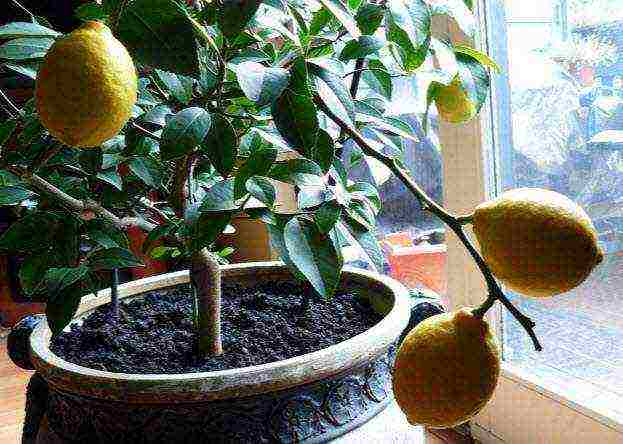
Room lemon - a short description
At home, lemons are grown in flower pots or tubs. Growing a lemon in a tub, you can get from 10-30 fruits every year from a young plant to 200 from an adult. Lemons, which are not inferior in quality to the southern varieties, can be removed from a tree about one and a half meters in height. You can grow a houseplant from a lemon seed, but truly delicious fruits are obtained only from varietal plants. Lemon is a perennial plant and it blooms profusely, although the flowers are not too noticeable behind the dense foliage, but the room is filled with a fresh aroma from essential oils secreted by all parts of the plant.
Growing features
Growing lemon at home is not as easy as other indoor flowers. A home tree requires a spacious, well-lit room and constant attention. But there are also obvious advantages - durability, pleasant smell, tasty and healthy fruits.
Several years pass from the moment of planting to the receipt of the first fruits, so please be patient and wait for your tree to bloom and give you the first medium-sized lemons. Over time, the tree will get stronger, and will delight you with a more generous harvest.
When growing indoor lemon, you must comply with the prerequisites:
- Bright room.
- Regular airing.
- Good drainage.
- Regular feeding.
- Cool wintering.
Planting lemon
If you decide to grow lemon from a seedling, pay attention to the "pedigree". It will be difficult for a fruiting tree from the subtropics to acclimatize. We recommend choosing seedlings from indoor plants or from a tree that lives in your climate. Lemons from the Caucasus, grafted on trifoliate, are suitable for growing in cool rooms - winter gardens or greenhouses. At home, the plant is likely to die. When choosing a seedling, carefully study the information about it.
When planting, the root collar should be buried only 5 mm into the ground. The ground level is 1 centimeter below the edge of the pot. This is necessary so that the root collar does not rot, and the soil is not washed off during watering. After planting, spray the seedling and water with a weak solution of potassium permanganate. Place the pot in a lighted place, but protect the leaves from direct sunlight, shade the tree if necessary.
Lemons do not like to move from place to place, so choose a permanent home for the plant and do not turn it abruptly so that the house flower can develop normally.
Optimal time
The best time to plant is late winter – early spring, as the natural growing season begins at this time.
The soil
Pour loose and nutritious soil into the pot after laying the drainage. Soil composition:
- Light loam (meadow sod) - 2 parts.
- Leafy land - 2 parts.
- Dung humus - 1 part.
- Coarse sand - 1 part.
On ordinary land from a summer cottage, a lemon will bear fruit poorly.
If you cannot assemble such a complex composition, buy Lemon or Rose earths in a flower shop.
Important! The tree will grow in the same soil for several years, so the correct selection of the substrate and regular feeding are very important.
Care features
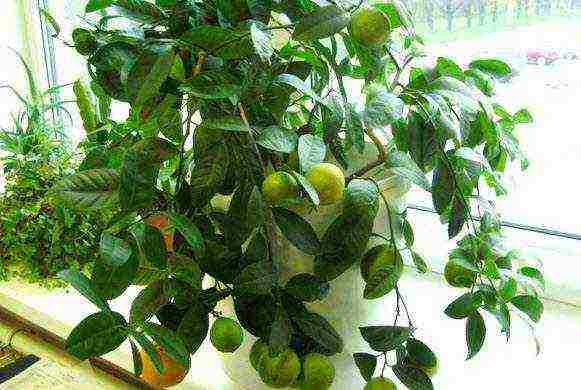
Lack of sunlight shouldn't kill the plant. When the days lengthen, the growth of the tree is activated, but at the same time fruiting is delayed. The southern and eastern windows are suitable for a houseplant. The most favorable place for lemon is the sills of the eastern windows, on which in the morning the sun's rays are bright, but not scorching. In hot summer, shield the flowerpot from the sun with a gauze curtain.
Indoor lemons do not like changes in light and rearrangements, the growth and development of fruits may slow down a little, but the tree will form correctly when turned.
Advice. In winter, it is advisable to arrange daylight illumination for 6 hours a day. Place an incandescent or fluorescent light bulb 60 cm above the tree.
Humidity
The most difficult period for indoor plants is October-March. The air in the apartment at this time is dry due to heating. Move the pot away or cover the batteries with a damp cloth. Spray the lemon periodically, but do not get carried away so as not to cause the development of the fungus. Place a cup of water in or near the pot.
In the summer, it is useful to have a cool shower once a week and wipe the leaves with a damp sponge. This is necessary so that the plant can breathe fully.
Important! The plant reacts painfully to changes in air humidity, dry air is especially dangerous at high temperatures during flowering and fruit formation. Flowers and ovaries may crumble. The more humid the air, the longer the leaves of the plant live.
Watering
In May and September, lemons should be watered daily, but in moderation. Swampy soil is categorically unsuitable, but overdried soil can also destroy the tree. Water the lemon less often during the winter, but keep it moist.
Important! Do not pour lemons with cold water or in the sun. The optimal watering time is morning or evening.
Temperature
The optimum temperature for the development of shoots and leaves is + 17 ° С, for the growth of fruits the temperature should be higher - + 21 ... 22 ° С. Lemons do not survive the heat well, especially in low humidity. In summer, when it gets warmer, flowers and ovaries can fall off, and temperature drops in autumn and winter can lead to falling leaves.
Attention! The soil temperature should be close to the air temperature. It is dangerous to bring lemon from the open air into a heated room. When it gets cold, try to gradually move the pot of the plant so that it can adapt to the new conditions.
Top dressing and fertilization
Fertilizers should be applied to the soil in moderation, but regularly, since their excess is harmful to plants.
By the state of the leaves, shoots and fruits, one can judge what kind of nutrition the lemon needs:
- The leaves turn yellow, the number of fruits decreases, and they become smaller - there is not enough nitrogen.
- The leaves turn pale and fall off, and the fruits are deformed and coarse - phosphorus deficiency.
- The leaves grow, and the fruits become smaller - potassium starvation.
- The tops of the branches dry out, the leaves turn pale and turn yellow, the lemon does not bloom and does not bear fruit - there is little iron.
It is recommended to fertilize lemons with 0.5% ammonium nitrate combined with potassium salt. With a lack of phosphorus, superphosphate is used.
In the summer, when the plant can be taken out of the house, you can feed it with organic fertilizer (bird droppings or water in which the meat was washed). It is not necessary to apply all fertilizers at the same time - lemons suffer from excessive feeding.
Carry out the planned feeding twice a month in the summer; from October to February, you do not need to feed the lemon.
Pruning
When growing indoor lemon, it is important not to let it grow to the size of a tree, especially since this plant is prone to forming long branches. If the bush is not cut, the crown will become too large. When pruning, part of the branches is removed after the fifth leaf - the crown from such a haircut will become productive and compact.
Lemon transplant
The fact that it is time to replant the lemon is evidenced by the roots sticking out of the drainage hole, but this is a case of extreme neglect. A planned transplant should be carried out as the tree grows, each next flower pot should be slightly larger than the previous one. There are circumstances of a forced transplant, for example, a pot may break or you will feel an unpleasant odor from the soil.
If the lemon does not grow well, it can be transplanted in the fall, although the optimal time is the end of February, before active growth begins, or the middle of summer.
- Carefully take out the plant, cut off the broken and damaged roots, and sprinkle them with crushed coal or Kornevin. It is not necessary to completely shake off the earth lump.
- Place a drain on the bottom of the pot and add some river sand. Above - a layer of soil.
- Cut off some of the branches to make it easier for the roots to feed the plant.
- Make a depression in the soil, set the lump so that the neck is just below the edge of the pot. If you need to raise, fill up the earth.
- Sprinkle soil around the edges in layers, making sure that the trunk is in the middle of the pot.
- Trample down the soil with your hands so that there are no voids.
- Pour with settled water and loosen the soil a little.
Advice. To make the lemon easier to bear stress, sprinkle it with Zircon and cover it with foil for 5-7 days.
Reproduction
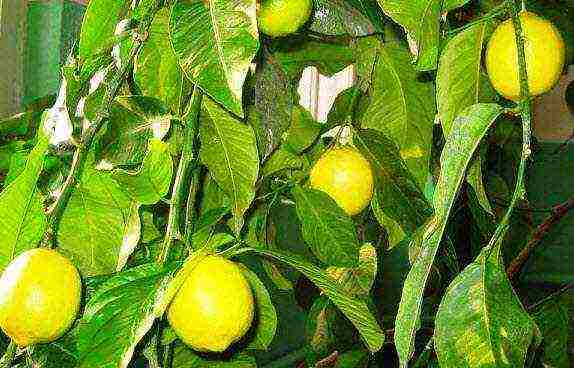
Lemon propagation
Lemons can be cultivated by cuttings or seeds. A tree that has grown from a seed will bloom and begin to bear fruit no earlier than after 8 years. If you plant a cutting, you will wait for your own lemons in 4 years. A baby lemon that has grown from a seed does not necessarily inherit the characteristics of the variety from the parent tree, and identity is guaranteed when propagated by cuttings. But trees and seeds are more resistant to disease and better adapt to life in captivity.
Seed propagation
You can get the Lemon Seed from any ripe fruit. Each lemon contains several seeds, take them out and plant several at a distance of 5 cm. It is better to plant seeds from several fruits.
Planting soil - well-drained peat and flower soil in a 1: 1 ratio. Deepen the seeds 1 cm and keep the soil moist without overflowing. At room temperature, the sprouts should appear in two weeks. Pick the tallest ones and delete the rest. Cover the sprout with a jar and place in a well-lit place without direct sunlight. Ventilate the sprout for several hours each day by removing the can.
When a few true leaves appear, plant the sprouts in pots up to 10 cm in diameter with good drainage. When replanting, try to keep the roots and soil around them. Pour a mixture of peat and soil for flowers into the pot. Transplant the plant that has grown up to 15-20 centimeters into an "adult" pot.
Propagation by cuttings
In the spring, semi-lignified twigs about 10 cm long with several leaves are cut off, and rooted in a homemade greenhouse with high humidity and temperature. Soil: peat and soil for flowers.
Lay drainage at the bottom of the pot, on top - a 5 cm layer of a mixture of turf and sand (6: 1), then - a mixture of sand and moss. This layer will mainly contain the root system of the future plant. Plant a cutting, water it and spray it with warm water. Cover with a can.
It is necessary to spray the cutting twice a day with water of about + 25 ° C until rooting occurs. At room temperature, the cutting should take root in 3-4 weeks. After that, remove the can for a few hours a day, and after a week, remove it completely. After another 7 days, you can transplant the cutting into a small pot with nutritious soil and reliable drainage. After a year, you can transplant the lemon into a regular pot, and after 3-4 years it will begin to bloom.
Bloom
The tops of young shoots of lemon are pink-purple in color. The oval toothed leaves contain an essential oil. Leaves are replaced after 2-3 years.Large lemon flowers (4-5 cm) bloom in spring five weeks after the bud appears, flowering lasts more than two months. After the petals fall off, the fruit is tied, ripening in 200 days or more.
If a young plant begins to bloom in the first years of life, it is advisable to cut off the buds so that the tree can develop normally. When the buds appear a second time, they are no longer torn off - the lemon itself "decides" how many fruits it can feed. The extra buds will fly around by themselves. You can allow flowering when the tree already has at least 20 leaves. It is believed that each fruit requires at least 10 mature leaves.
Post-flowering care
Lemon grows, blooms and bears fruit all year round. One tree may contain ripe fruits, ovaries, flowers and buds. It is not necessary to pick off the faded inflorescences, as they turn into ovaries. If the lemon blooms in summer, the fruit ripens faster than in spring bloom.
Problems, diseases, pests
Many diseases of ornamental lemons are caused by improper care. With a lack of light and nutrients, lemon leaves brighten. Buds and leaves fly around if there is not enough moisture. The dryness of the indoor air is especially difficult for the plant, flowering may stop, the leaves darken and fall off.
Pests also often settle on the plant:
- Scabbards lead to the drying of branches, leaves and the death of the lemon. Remove the pests with a toothbrush and wash the lemon with soapy water.
- The spider mite settles on the wrong side of the leaves and the cobweb gradually envelops the entire tree. Spray with Actelika 0.15% solution three times, every 10 days.
- Mealybug leaves a sticky discharge on the leaves. Fruits and leaves fall off. It is recommended to inspect the plant and collect larvae.
- Citrus aphid. Actelika solution helps to get rid of this pest.
- Thrips and whiteflies also settle on lemons, which must be collected by hand, and the tree must be washed under the shower and treated with soapy water.
Popular types of indoor lemon
Meyer's lemon
Lemon Pavlovsky
Lemon Lunardio
Ponderosa lemon
Lemon Jubilee
- Meyer's lemon
- Lemon Pavlovsky
- Lemon Lunardio
- Ponderosa lemon
- Lemon Jubilee
Useful Tips
- If the lemon leaves turn brown, increase the indoor humidity and water the plant more often.
- Small leaves and thin shoots indicate that the lemon urgently needs to be fed and placed in a brighter place.
- Leaves dry and curl when there is not enough light and moisture. Spray a lemon every day, water and feed with complex fertilizers.
Answers on questions
The lifespan of indoor lemon
With careful attention and proper care, lemons live up to 45 years. An indoor flower dies ahead of time due to diseases and pests.
Why isn't the lemon blooming?
You have probably planted the plant in a pot that is too tight. Transplant it and feed it with complex fertilizer.
What if the lemon drops its leaves?
For lemon, leaf fall is a reaction to stress. Perhaps after the summer you moved it into a room or, conversely, sharply placed it under bright rays. Arrange artificial lighting or create a shadow. The reason may be excessive or insufficient watering - souring of the soil and drying out of the earthy coma are equally harmful for lemons. If the tree has not been watered for a long time, do not moisten the soil abundantly, add water little by little over several days.
Why does lemon shed fruit?
Lemon sheds fruits when it does not have enough strength to develop them. The first flowers that appear on a young lemon must be cut off, and only 2 fruits can be left on a three-year-old plant. In the future, each fruit should have at least 10 leaves.
How to arrange wintering?
The main task during the winter is to preserve the leaves. The room should not be too hot - no more than + 20оС. Keep the plant pot away from batteries and place a container of water next to it.If the windows are well protected from cold air, arrange a tree in the southeast or southwest window. Watering lemon in winter should not be as abundant as in the warm season.

Citrus lovers have long figured out how to grow lemon at home. There are several ways how to implement your plans, the main thing is to follow the existing rules for planting and caring for seedlings, otherwise you will not be able to get a citrus tree on your windowsill.
What kind of lemon is best to grow in an apartment?
There are many known species of this exotic plant that are suitable for home cultivation, but it is worth choosing undersized varieties that give a lot of harvest. Among the best and most popular are the following options:
- "Meyer"... If you are interested in how to grow a fruiting lemon, then it is recommended to choose this variety for planting, which bears fruit early and in large quantities. The tree reaches a height of 1-1.5 m. Flowering is observed throughout the year. The fruits are not too sour, but they are juicy.
- "Novogruzinsky"... A vigorous tree that needs regular pruning and crown formation. The fruits are oval and slightly elongated, and they are loved for their exquisite taste and powerful aroma. When grown, you can get a lot of fruits. The plant survives normally in dry air in winter.
- "Panderoza"... The variety is not demanding on growing conditions, which is why it has become popular. It is worth noting the presence of huge fruits, as specimens weighing 1 kg were recorded. Their flesh is light green.
How to plant a lemon correctly?
There are two ways you can use to grow an exotic tree at home: using seeds and cuttings. Each option has its own advantages and disadvantages. You can get the planting material yourself or buy it in the store. When figuring out how to plant a lemon at home, it is worth noting that planting seeds is considered the best, since everyone can get them. In addition, an adult plant grown with this method will be much more viable than a tree obtained from a cuttings.
How to plant a pitted lemon?
For this option, prepare seeds that should be well formed and free from defects. It is best to use several seeds from different citrus fruits. Immediately after removing the seeds, soak them for several hours in water and you can proceed to planting:
- For growing lemon from seed at home, small containers are used, filled with suitable soil, mixing part of the flower soil and part of the peat. Don't forget drainage.
- Deepen the bones by 1 cm so that the distance between them is 5 cm, and 3 cm to the walls of the container.
- It is important to monitor the moisture content of the earth, but it cannot be flooded either. Please note that a temperature of 18-22 ° C is suitable for seedlings. To create conditions similar to greenhouses, the container can be covered with foil, glass or a jar.
- The pot should be exposed to light, but not in direct sunlight. Be sure to ventilate every day by removing the shelter.
- If all the recommendations regarding how to properly grow lemon from seeds are taken into account, then seedlings will appear in two weeks. Select the most viable ones, and the rest can be pulled out. After the appearance of true leaves, a dive is carried out into separate small containers. It is necessary to transplant the plant when the height of the seedling reaches 20 cm.

How to plant a lemon sapling?
Grow will grow, so transplanting into a more comfortable and spacious pot cannot be avoided. In the instructions on how to plant a lemon at home, it is indicated that you need to remove the seedling along with the earthy clod, which will speed up its adaptation in a new place. If you got a seedling without it, then insert it into a new pot and carefully distribute the roots so that they do not break and do not get tangled. Be sure to water the soil, lightly compacting it.
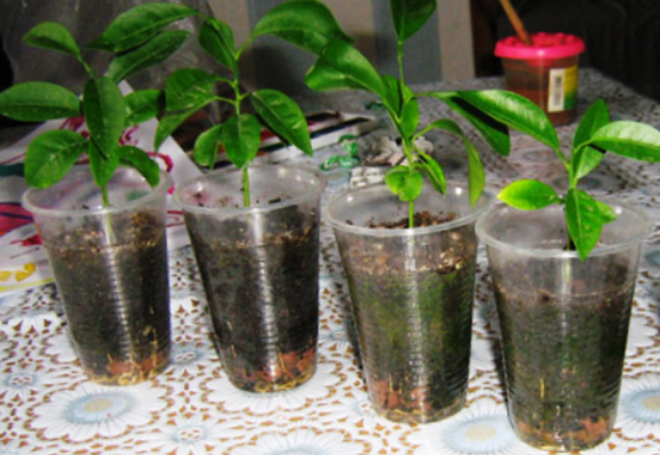
How to plant a lemon from a twig?
For the procedure, prepare river sand, rinse it and bake it in the oven to remove bacteria. Also, get a citrus primer. There is a certain scheme for planting a room lemon with a handle:
- Cut off shoots that should not be more than a year old from a healthy and fruitful tree. The branches should be about 10 cm long and have 3-4 developed buds. The cut at the bottom should be made closer to the kidney at a right angle, and at the top - at an angle of 45 ° at a distance of 5 mm from the upper kidney. Remove the sheet from the bottom completely, and cut the rest in half.
- Soak the cuttings in a root-forming solution for 10-12 hours. After that, dip the cut into charcoal to protect the planting material from decay.
- Bury the branches in wet sand to a depth of 1.5-2 cm. Then spray with lukewarm water. To make a makeshift greenhouse, cover the stalk with a jar. Place the container in a well-lit area, but avoid direct sunlight. Those who are interested in how to grow lemon from cuttings should know that it is important to keep the sand moist at all times, and spraying should be carried out every day.
- After 2-3 weeks, the first roots should appear. New leaves will testify to successful rooting. Remove the hardening jar for several hours every day. After two weeks, it can be completely removed. After that, you can carry out a transplant.
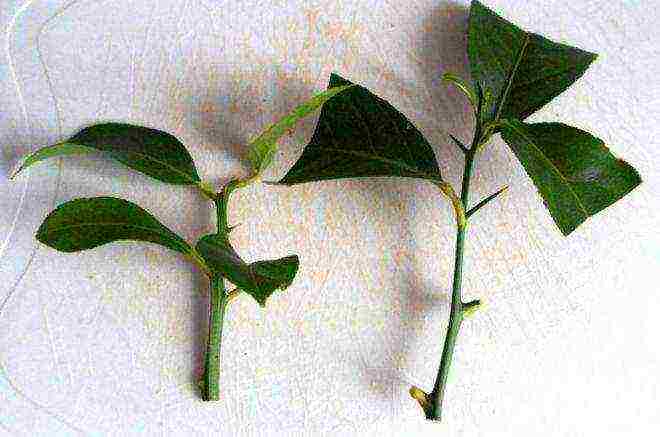
How to grow lemon at home?
In order to see fruits on a tree, it is important to properly care for it. Experienced gardeners give some practical tips on how to grow lemon at home:
- At the end of autumn, to help the plant adapt to the approaching cold weather, gradually reduce the temperature to 15 ° C. At the same time, it is important to increase the daylight hours, otherwise the citrus will shed the foliage.
- Growing lemon at home involves wrapping the pot in a blanket in winter to protect the roots from hypothermia.
- After every 5-6 waterings, it is recommended to loosen the soil so that oxygen flows to the roots.
- One easy way to make lemon bear fruit is to wire the side shoot near the trunk. When the branch blooms, then the dressing should be removed.
Growing lemon at home - soil
Citrus belongs to unpretentious plants and it can take roots in any land. You can use a mixture that includes sod land, river sand and humus. In addition, gardeners recommend including wood ash in the soil mixture, which will feed the sprouts. Growing lemon at home in a pot can be done using soils designed for indoor plants, but you need to add a little peat to them. When planting the cuttings on top of the ground, add a layer of sand to help take root faster.
To grow a healthy shrub, be sure to add a layer of drainage to the bottom of the pot, as this will prevent moisture from stagnating, which is detrimental to the plant. For it, you can use small stones or pebbles, grated foam, coarse sand or expanded clay. Experts give advice - in order to provide the plant with a nutrient medium, put a layer of peat or dry manure on top of the drainage. Its height should be no more than 2 cm.
Potted indoor lemon care - watering
In order to saturate the soil well, it is recommended to add water in 3-4 doses with short interruptions. When we start dripping from the drainage hole, it means that watering needs to be completed. Carrying out indoor lemon care at home, it is important to take into account that irrigation is carried out only with warm water and in the morning. In winter, water it 2-3 times a week. If the room temperature is + 10 ° C, then add water 1-2 times a month.
Indoor lemon care - feeding
Fertilizers are of great importance for citrus crops.With a lack of minerals, foliage wilting and poor flowering are observed. To understand how to grow lemon properly, follow these tips:
- During flowering and fruiting, fertilizer must be applied every 14 days. It is best to use organic, for example, "Gumi-Omi Kuznetsova Lemon". For 1 liter of water, 1 tbsp is taken. a spoon. Under small bushes, apply 0.5 tbsp., And for large volumes, increase the dose.
- Caring for lemon at home in winter means reducing the amount of dressing to 1 time per month.
- To grow a healthy plant, it is helpful to spray the back of the leaves with a fertilizer solution.
- After transplanting, feed in a month. Immediately before placing the bush in a new pot, it is recommended to water it with Kornesil to restore the root system.
Home Lemon Care - Pruning
It is recommended to carry out the procedure in the spring before the beginning of the growth period. It is better to form the crown on a low trunk (15-18 cm). In the first year of life, cut the trunk at a height of about 20 cm. When growing a lemon from a seed or cutting, keep in mind that the shoots are cut so that 4-5 leaves remain. It should be borne in mind that in most varieties, fruits are tied on branches of the 4th-5th order, so the plant should be branched.

How to propagate homemade lemon?
Several methods can be used to increase the number of citrus bushes. It was described above how to grow a lemon from cuttings and seeds, but there is another option - the use of cuttings.
- The stock must be grown for 1.5-2 years. The lemon stalk should be 6-7 cm long.
- Split the rootstock and place the stalk in it, and then carefully wrap the grafting site with foil to create a greenhouse effect.
- The vaccine will take root in about 45-60 days, and then remove the film.
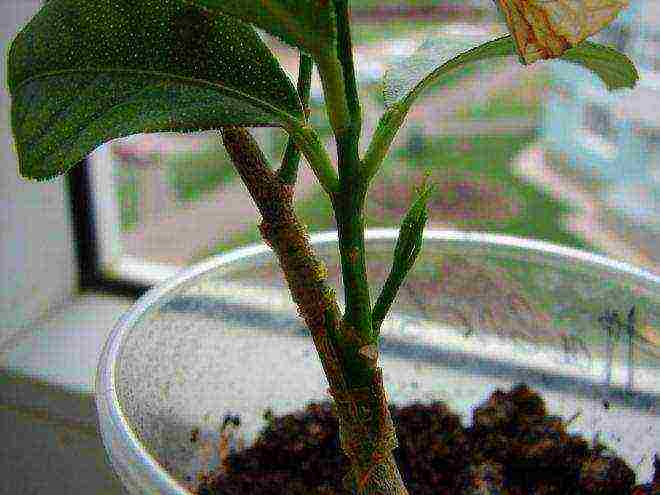
Growing lemon - diseases and pests
If you do not follow the tips presented above, the bush can infect diseases:
- Fungal diseases, for example, root rot, late blight, and so on. Remove the affected areas, and then disinfect - spraying with chemical insecticides.
- If the care is improperly carried out, the lemon is affected by diseases and pests, so infectious diseases are serious. They fight them with special means.
- The appearance of viral diseases is not excluded, and then the plant must be disposed of.
- Understanding how to grow a lemon, it is worth noting that the main pests are aphids, scale insects, spider mites and whiteflies. Remove insects and wash the stems and leaves with soapy water. Experts recommend to carry out cold ablutions of the bush twice a week.


